An Introduction to ARC 3.0: Alkali.ne Rydberg Calculator#
Authors: Elizabeth J. Robertson, Nikola Šibalić, Robert M. Potvliege, Matthew P. A. Jones
Updated 15/11/2020
This notebooks gives examples of new functionality introduced in ARC version 3.0: support for calculations of states, Stark maps and pair-state interactions for Alkaline Earths, pertubative van der Waals \(C_6\) calculations in manifold of energy-degenerate states, inter-species pair-state calculatons, and general new calculation methods for working with Wavefunctions (supported for Alkali only), Optical lattices in 1D (calculation of recoil energies, Bloch bands, Wannier states…), atom-surface van der Waals interactions and calculation of dynamic polarisabilities (magic wavelengths and other details useful for atom-trapping). For introduction to Rydberg-state calculations, also available in the original ARC version, we point users to the An Introduction to Rydberg atoms with ARC . For general introduction into physics of Rydberg states and their properties and applications see Rydberg Physics ebook published by IOP.
For more details please see E. J. Robertson, N. Šibalić, R. M. Potvliege, M. P. A. Jones, ARC 3.0: An expanded Python toolbox for atomic physics calculations, Computer Physics Communications 261, 107814 (2021) https://doi.org/10.1016/j.cpc.2020.107814
Contents:
Preliminaries: general note on using ARC with Alkaline Earths
Pair-state interactions between Rydberg states of Alkaline Earths
3.1 Pertubative C6 calculation in the manifold of degenerate states
Atom-surface van der Waals interactions (:math:`C_3 calculation) <#Atom-surface-van-der-Waals-interactions-(C3-calculation)>`__
Calculations of dynamic polarisability and magic wavelengths for optical traps
Preliminaries: general note on using ARC with Alkaline Earths#
Dipole matrix elements for Alkaline Earths are calculated using single active electron approximation. DME are calculated based using semi-classical approximation. DME obtained in this way are in general correct for higher lying states only. See publication for details.
Install latest version of ARC
[7]:
!pip install ARC-Alkali-Rydberg-Calculator --upgrade --no-cache-dir
Collecting ARC-Alkali-Rydberg-Calculator
Downloading ARC-Alkali-Rydberg-Calculator-3.0.5.tar.gz (26.5 MB)
|████████████████████████████████| 26.5 MB 3.6 MB/s eta 0:00:01
Requirement already satisfied, skipping upgrade: scipy>=0.18.1 in /home/nikola/anaconda3/lib/python3.7/site-packages (from ARC-Alkali-Rydberg-Calculator) (1.5.2)
Requirement already satisfied, skipping upgrade: numpy>=1.16.0 in /home/nikola/anaconda3/lib/python3.7/site-packages (from ARC-Alkali-Rydberg-Calculator) (1.19.1)
Requirement already satisfied, skipping upgrade: matplotlib>=1.5.3 in /home/nikola/anaconda3/lib/python3.7/site-packages (from ARC-Alkali-Rydberg-Calculator) (3.3.1)
Requirement already satisfied, skipping upgrade: sympy>=1.1.1 in /home/nikola/anaconda3/lib/python3.7/site-packages (from ARC-Alkali-Rydberg-Calculator) (1.6.2)
Requirement already satisfied, skipping upgrade: lmfit>=0.9.0 in /home/nikola/anaconda3/lib/python3.7/site-packages (from ARC-Alkali-Rydberg-Calculator) (0.9.14)
Requirement already satisfied, skipping upgrade: certifi>=2020.06.20 in /home/nikola/anaconda3/lib/python3.7/site-packages (from matplotlib>=1.5.3->ARC-Alkali-Rydberg-Calculator) (2020.6.20)
Requirement already satisfied, skipping upgrade: cycler>=0.10 in /home/nikola/anaconda3/lib/python3.7/site-packages (from matplotlib>=1.5.3->ARC-Alkali-Rydberg-Calculator) (0.10.0)
Requirement already satisfied, skipping upgrade: pyparsing!=2.0.4,!=2.1.2,!=2.1.6,>=2.0.3 in /home/nikola/anaconda3/lib/python3.7/site-packages (from matplotlib>=1.5.3->ARC-Alkali-Rydberg-Calculator) (2.4.7)
Requirement already satisfied, skipping upgrade: kiwisolver>=1.0.1 in /home/nikola/anaconda3/lib/python3.7/site-packages (from matplotlib>=1.5.3->ARC-Alkali-Rydberg-Calculator) (1.2.0)
Requirement already satisfied, skipping upgrade: pillow>=6.2.0 in /home/nikola/anaconda3/lib/python3.7/site-packages (from matplotlib>=1.5.3->ARC-Alkali-Rydberg-Calculator) (7.2.0)
Requirement already satisfied, skipping upgrade: python-dateutil>=2.1 in /home/nikola/anaconda3/lib/python3.7/site-packages (from matplotlib>=1.5.3->ARC-Alkali-Rydberg-Calculator) (2.8.1)
Requirement already satisfied, skipping upgrade: mpmath>=0.19 in /home/nikola/anaconda3/lib/python3.7/site-packages (from sympy>=1.1.1->ARC-Alkali-Rydberg-Calculator) (1.1.0)
Requirement already satisfied, skipping upgrade: six>1.10 in /home/nikola/anaconda3/lib/python3.7/site-packages (from lmfit>=0.9.0->ARC-Alkali-Rydberg-Calculator) (1.15.0)
Requirement already satisfied, skipping upgrade: uncertainties>=3.0 in /home/nikola/anaconda3/lib/python3.7/site-packages (from lmfit>=0.9.0->ARC-Alkali-Rydberg-Calculator) (3.1.2)
Requirement already satisfied, skipping upgrade: asteval>=0.9.12 in /home/nikola/anaconda3/lib/python3.7/site-packages (from lmfit>=0.9.0->ARC-Alkali-Rydberg-Calculator) (0.9.17)
Building wheels for collected packages: ARC-Alkali-Rydberg-Calculator
Building wheel for ARC-Alkali-Rydberg-Calculator (setup.py) ... done
Created wheel for ARC-Alkali-Rydberg-Calculator: filename=ARC_Alkali_Rydberg_Calculator-3.0.5-cp37-cp37m-linux_x86_64.whl size=27213900 sha256=b45d2699b977ba32e0f98c4d394c1c7ed6eb76d242c5b434f754bd7b679489be
Stored in directory: /tmp/pip-ephem-wheel-cache-o1_eqn86/wheels/65/1b/f7/d1bf9618d21b663745262ffab701b86d0f2cd64831c4d9c86d
Successfully built ARC-Alkali-Rydberg-Calculator
Installing collected packages: ARC-Alkali-Rydberg-Calculator
Attempting uninstall: ARC-Alkali-Rydberg-Calculator
Found existing installation: ARC-Alkali-Rydberg-Calculator 3.0.4
Uninstalling ARC-Alkali-Rydberg-Calculator-3.0.4:
Successfully uninstalled ARC-Alkali-Rydberg-Calculator-3.0.4
Successfully installed ARC-Alkali-Rydberg-Calculator-3.0.5
To use ARC in your Python project, import module as
[4]:
from arc import *
[6]:
import numpy as np
import matplotlib.pyplot as plt
General atom calculations with Alkaline earths#
[2]:
atom = Strontium88()
calc = LevelPlot(atom)
calc.makeLevels(5, 6, 0, 5, sList=[0, 1])
calc.drawLevels()
calc.showPlot()

NOTE: Interactive clickable plot, allowing finding wavelengths and frequencies for transitions beteen different states, opens if used from command line as in in python code.py or if notebook is initialised with stand-alone, instead inline figures. This requires calling following line after import of arc:
[3]:
from arc import *
%matplotlib qt
atom = Strontium88()
calc = LevelPlot(atom)
calc.makeLevels(5, 6, 0, 5, sList=[0, 1])
calc.drawLevels()
calc.showPlot()
We will use inline plots for the rest of this notebook, but it’s easy to switch
[4]:
%matplotlib inline
Test of vapour pressures#
[7]:
temperature = np.linspace(100 + 273.15, 700 + 273.15, 100)
numberDensity = []
interatomicSpacing = []
pressure = []
for t in temperature:
pressure.append(atom.getPressure(t))
numberDensity.append(atom.getNumberDensity(t))
interatomicSpacing.append(atom.getAverageInteratomicSpacing(t) * 1e6)
pressure = np.array(pressure)
fig, ax = plt.subplots(1, 2, figsize=(9, 3.5))
ax[0].semilogy(temperature - 273.15, numberDensity, "b-")
ax[0].set_xlabel("Temperature ($^{\circ}$C)")
ax[0].set_ylabel("Number density (cm$^{-3}$)")
ax[0].grid()
ax[1].semilogy(temperature - 273.15, interatomicSpacing, "r-")
ax[1].set_xlabel("Temperature ($^{\circ}$C)")
ax[1].set_ylabel("Average interatomic spacing ($\mu$m)")
ax[1].set_ylim(0.01, 10000)
plt.tight_layout()
plt.show()
f = plt.figure()
ax = f.add_subplot(111)
ax.semilogy(temperature - 273.15, pressure / 133.322, "g-")
ax.set_xlabel("Temperature ($^{\circ}$C)")
ax.set_ylabel("Pressure (torr)")
ax.grid()
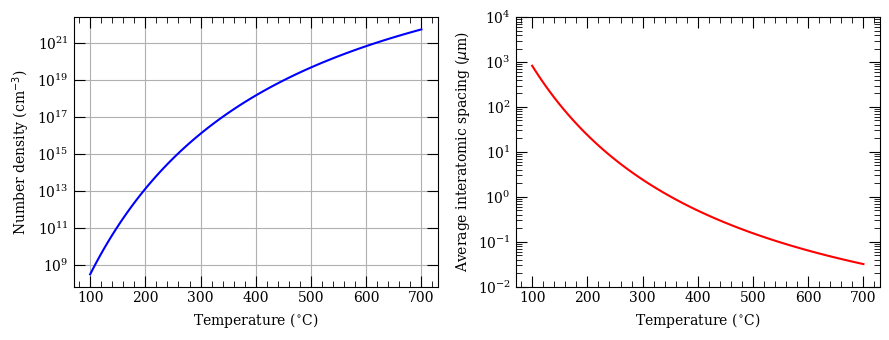
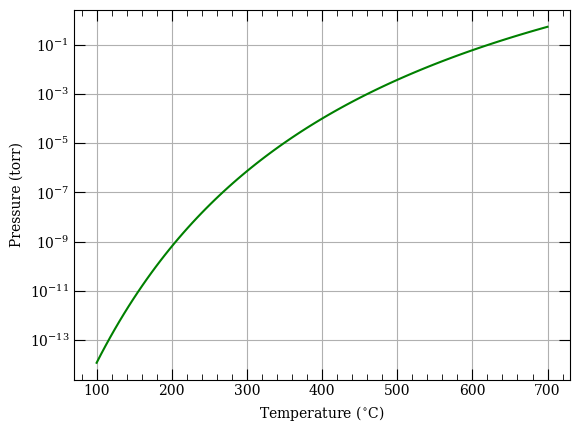
[9]:
print(atom.getPressure(400 + 273.15))
0.013336243497052324
Plot quantum defects#
[8]:
atom = Strontium88()
n = np.arange(15, 100, 1)
fig, axes = plt.subplots(1, 1, figsize=(7, 5))
axes.plot(
n,
atom.getQuantumDefect(n, 0, 0, s=0),
".",
label=("$%s$" % printStateStringLatex("n", 0, 0, s=0)),
)
axes.plot(
n,
atom.getQuantumDefect(n, 1, 1, s=0),
".",
label=("$%s$" % printStateStringLatex("n", 1, 1, s=0)),
)
axes.plot(
n,
atom.getQuantumDefect(n, 2, 1, s=1),
".",
label=("$%s$" % printStateStringLatex("n", 2, 1, s=0)),
)
axes.plot(
n,
atom.getQuantumDefect(n, 3, 3, s=0),
".",
label=("$%s$" % printStateStringLatex("n", 3, 3, s=0)),
)
axes.legend(loc=0)
axes.set_xlabel("$n$")
axes.set_ylabel("Quantum Defect $\delta_{n\ell j}$")
axes.set_title("Sr Quantum Defects")
plt.show()
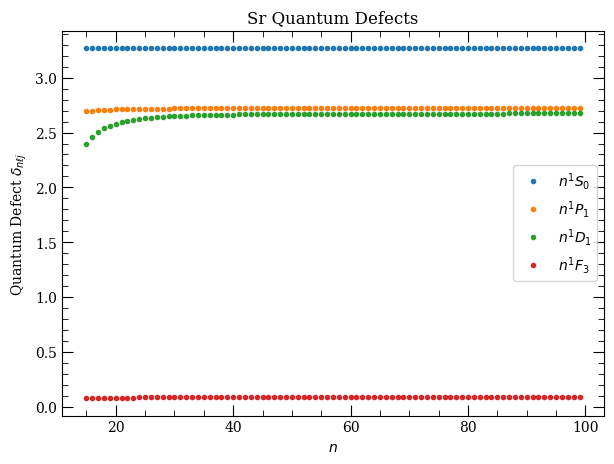
[11]:
atom = Strontium88()
n = np.arange(15, 100, 1)
fig, axes = plt.subplots(1, 1, figsize=(7, 5))
axes.plot(
n,
atom.getQuantumDefect(n, 0, 0, s=1),
".",
label=("$%s$" % printStateStringLatex("n", 0, 0, s=1)),
)
axes.plot(
n,
atom.getQuantumDefect(n, 1, 1, s=1),
".",
label=("$%s$" % printStateStringLatex("n", 1, 1, s=1)),
)
axes.plot(
n,
atom.getQuantumDefect(n, 2, 1, s=1),
".",
label=("$%s$" % printStateStringLatex("n", 2, 1, s=1)),
)
axes.plot(
n,
atom.getQuantumDefect(n, 3, 3, s=1),
".",
label=("$%s$" % printStateStringLatex("n", 3, 3, s=1)),
)
axes.legend(loc=0)
axes.set_xlabel("$n$")
axes.set_ylabel("Quantum Defect $\delta_{n\ell j}$")
axes.set_title("Sr Quantum Defects")
plt.show()
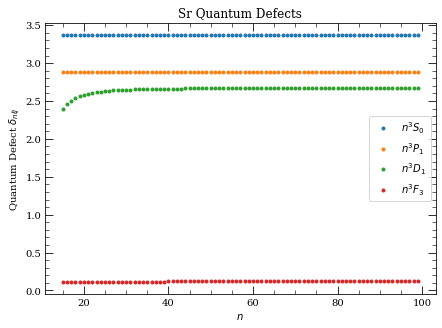
[12]:
atom = Strontium88()
atom.getEnergy(62, 2, 2, s=0)
print(
"%.3f nm"
% (atom.getTransitionWavelength(5, 0, 0, 5, 1, 1, s=0, s2=1) * 1e9)
)
print(
"%.3f THz"
% (atom.getTransitionFrequency(5, 0, 0, 5, 1, 1, s=0, s2=1) * 1e-12)
)
689.449 nm
434.829 THz
[13]:
atom = Strontium88(preferQuantumDefects=True)
atom.getEnergy(62, 2, 2, s=0)
[13]:
-0.003826740461064719
Stark maps with Alkaline Earths#
[14]:
calc = StarkMap(Strontium88())
# Target state
n0 = 37
l0 = 2
j0 = 1
mj0 = 1
# Define max/min n values in basis
nmin = n0 - 5
nmax = n0 + 5
# Maximum value of l to include (l~20 gives good convergence for states with l<5)
lmax = 20
# Initialise Basis States for Solver : progressOutput=True gives verbose output
calc.defineBasis(n0, l0, j0, mj0, nmin, nmax, lmax, progressOutput=True, s=1)
Emin = 0.0 # Min E field (V/m)
Emax = 4.0e2 # Max E field (V/m)
N = 1001 # Number of Points
# Generate Stark Map
calc.diagonalise(np.linspace(Emin, Emax, N), progressOutput=True)
# Show Sark Map
calc.plotLevelDiagram(progressOutput=True, units=0, highlightState=True)
calc.ax.set_ylim(-2914, -2904)
calc.showPlot(interactive=False)
# Return Polarizability of target state
print(
"%.5f MHz cm^2 / V^2 "
% calc.getPolarizability(showPlot=True, minStateContribution=0.9)
)
Found 600 states.
Generating matrix...
100%
Finding eigenvectors...
100%
plotting...


-20.46519 MHz cm^2 / V^2
[19]:
calc = StarkMap(Strontium88())
# Target state
n0 = 37
l0 = 0
j0 = 1
mj0 = 0
# Define max/min n values in basis
nmin = n0 - 5
nmax = n0 + 5
# Maximum value of l to include (l~20 gives good convergence for states with l<5)
lmax = 20
# Initialise Basis States for Solver : progressOutput=True gives verbose output
calc.defineBasis(n0, l0, j0, mj0, nmin, nmax, lmax, progressOutput=True, s=1)
Emin = 0.0 # Min E field (V/m)
Emax = 4.0e2 # Max E field (V/m)
N = 1001 # Number of Points
# Generate Stark Map
calc.diagonalise(np.linspace(Emin, Emax, N), progressOutput=True)
# Show Sark Map
calc.plotLevelDiagram(progressOutput=True, units="GHz", highlightState=True)
calc.ax.set_ylim(-2950, -2900)
calc.showPlot(interactive=False)
# Return Polarizability of target state
print(
"%.5f MHz cm^2 / V^2 "
% calc.getPolarizability(showPlot=True, minStateContribution=0.9)
)
Found 620 states.
Generating matrix...
100%
Finding eigenvectors...
100%
plotting...
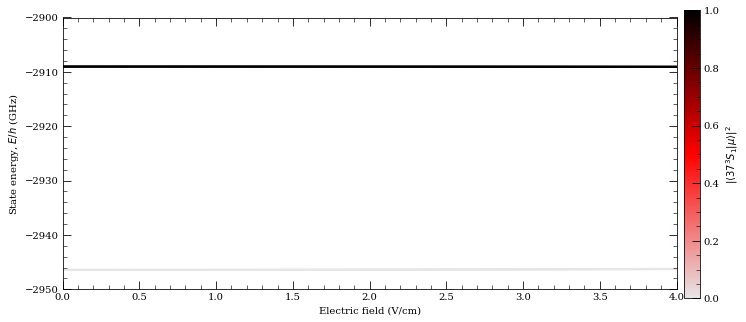
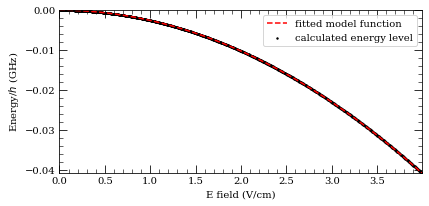
5.11812 MHz cm^2 / V^2
[21]:
calc = StarkMap(Strontium88())
# Target state
n0 = 37
l0 = 1
j0 = 1
mj0 = 0
# Define max/min n values in basis
nmin = n0 - 5
nmax = n0 + 5
# Maximum value of l to include (l~20 gives good convergence for states with l<5)
lmax = 20
# Initialise Basis States for Solver : progressOutput=True gives verbose output
calc.defineBasis(n0, l0, j0, mj0, nmin, nmax, lmax, progressOutput=True, s=1)
Emin = 0.0 # Min E field (V/m)
Emax = 4.0e2 # Max E field (V/m)
N = 1001 # Number of Points
# Generate Stark Map
calc.diagonalise(np.linspace(Emin, Emax, N), progressOutput=True)
# Show Sark Map
calc.plotLevelDiagram(progressOutput=True, units="GHz", highlightState=True)
calc.ax.set_ylim(-2835, -2822)
calc.showPlot(interactive=False)
# Return Polarizability of target state
print(
"%.5f MHz cm^2 / V^2 "
% calc.getPolarizability(showPlot=True, minStateContribution=0.9)
)
Found 620 states.
Generating matrix...
100%
Finding eigenvectors...
100%
plotting...


42.33374 MHz cm^2 / V^2
[22]:
calc = StarkMap(Strontium88())
# Target state
n0 = 56
l0 = 2
j0 = 2
mj0 = 0
s = 0
# Define max/min n values in basis
nmin = n0 - 7
nmax = n0 + 7
# Maximum value of l to include (l~20 gives good convergence for states with l<5)
lmax = 20
# Initialise Basis States for Solver : progressOutput=True gives verbose output
calc.defineBasis(n0, l0, j0, mj0, nmin, nmax, lmax, progressOutput=True, s=s)
Emin = 0.0 # Min E field (V/m)
Emax = 4.0e2 # Max E field (V/m)
N = 1001 # Number of Points
# Generate Stark Map
calc.diagonalise(np.linspace(Emin, Emax, N), progressOutput=True)
# Show Sark Map
calc.plotLevelDiagram(progressOutput=True, units="GHz", highlightState=True)
calc.ax.set_ylim(-1148, -1138)
calc.showPlot(interactive=False)
# Return Polarizability of target state
print(
"%.5f MHz cm^2 / V^2 "
% calc.getPolarizability(showPlot=True, minStateContribution=0.9)
)
Found 294 states.
Generating matrix...
100%
Finding eigenvectors...
100%
plotting...
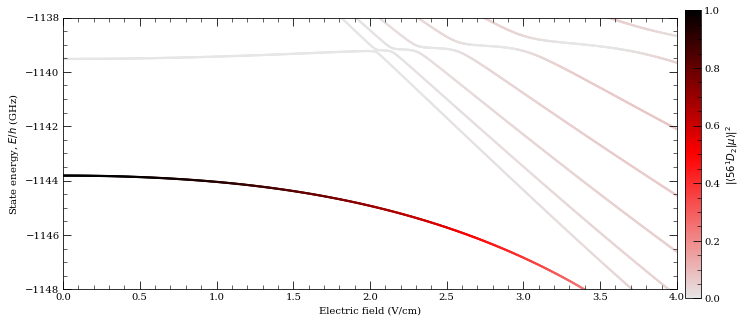

466.49246 MHz cm^2 / V^2
Pair-state interactions between Rydberg states of Alkaline Earths#
[23]:
atom = Strontium88()
nlist = np.arange(25, 100, 1)
fig, axes = plt.subplots(1, 1, figsize=(10, 6))
s = 0
l1 = 1
j1 = 1 # ^1P_1
l2 = 0
j2 = 0 # ^1S_{0}
energyDefect = []
for n in nlist:
energyDefect.append(
atom.getEnergyDefect2(n, l1, j1, n, l1, j1, n + 1, l2, j2, n, l2, j2, s)
/ (C_h)
* 1e-9
)
axes.plot(
nlist,
energyDefect,
"r.",
label=r"$|n%s_%d,n%s_%d\rangle\rightarrow|(n+1) %s_%d,n %s_%d\rangle$"
% (
printStateLetter(l1),
int(j1),
printStateLetter(l1),
int(j1),
printStateLetter(l2),
int(j2),
printStateLetter(l2),
int(j2),
),
)
l1 = 1
j1 = 1 # ^1P_1
l2 = 0
j2 = 0 # ^1S_0
energyDefect = []
for n in nlist:
energyDefect.append(
atom.getEnergyDefect2(
n, l1, j1, n, l1, j1, n + 2, l2, j2, n - 1, l2, j2, s
)
/ (C_h)
* 1e-9
)
axes.plot(
nlist,
energyDefect,
"k.",
label=r"$|n%s_%d,n%s_%d\rangle\rightarrow |(n+2) %s_%d,(n_1) %s_%d\rangle$"
% (
printStateLetter(l1),
int(j1),
printStateLetter(l1),
int(j1),
printStateLetter(l2),
int(j2),
printStateLetter(l2),
int(j2),
),
)
axes.set_xlim(0, 100)
axes.legend(loc=0, fontsize=10)
axes.set_ylabel("Energy defect, $\Delta$ (GHz)")
axes.set_xlabel("Principal quantum number, $n$")
axes.grid()
plt.legend
plt.show()

[15]:
n0 = 40
l0 = 0
j0 = 0
mj0 = 0
# Target State
theta = 0
# Polar Angle [0-pi]
phi = 0
# Azimuthal Angle [0-2pi]
dn = 5
# Range of n to consider (n0-dn:n0+dn)
dl = 5
# Range of l values
deltaMax = 45e9 # Max pair-state energy difference [Hz]
# Set target-state
calc = PairStateInteractions(
Strontium88(), n0, l0, j0, n0, l0, j0, mj0, mj0, interactionsUpTo=1, s=0
)
# R array (um)
r = np.linspace(0.3, 1.5, 400)
# Generate pair-state interaction Hamiltonian
calc.defineBasis(
theta, phi, dn, dl, deltaMax, progressOutput=True, debugOutput=False
)
# Diagonalise
nEig = 250 # Number of eigenstates to extract
calc.diagonalise(r, nEig, progressOutput=True)
# Plot
calc.plotLevelDiagram()
# Zoom-on on pair state
calc.ax.set_xlim(0.3, 1.5)
calc.ax.set_ylim(-4, 4)
calc.showPlot() # by default program will plot interactive plots
# however plots are interactive only if open oin standard window
# and not in the %inline mode of the notebooks
Calculating Hamiltonian matrix...
matrix (dimension 330 )
Matrix R3 100.0 % (state 98 of 98)
/home/nikola/anaconda3/lib/python3.8/site-packages/numpy/core/_asarray.py:171: VisibleDeprecationWarning: Creating an ndarray from ragged nested sequences (which is a list-or-tuple of lists-or-tuples-or ndarrays with different lengths or shapes) is deprecated. If you meant to do this, you must specify 'dtype=object' when creating the ndarray.
return array(a, dtype, copy=False, order=order, subok=True)
Diagonalizing interaction matrix...
99% Now we are plotting...

[15]:
0
[12]:
value = []
nValue = [25, 30, 35, 40, 45, 50, 55, 60, 65, 70, 75, 80]
for n in nValue:
calculation1 = PairStateInteractions(
Strontium88(), n, 0, 0, n, 0, 0, 0, 0, s=0
)
state = printStateString(n, 0, 0, s=0) + " mj=0"
c6 = calculation1.getC6perturbatively(0, 0, 6, 65e9)
value.append(c6)
print("C_6 [%s] = %.5f GHz (mu m)^6" % (state, c6))
C_6 [25 1S 0 mj=0] = 0.00207 GHz (mu m)^6
C_6 [30 1S 0 mj=0] = 0.01997 GHz (mu m)^6
C_6 [35 1S 0 mj=0] = 0.12905 GHz (mu m)^6
C_6 [40 1S 0 mj=0] = 0.63257 GHz (mu m)^6
C_6 [45 1S 0 mj=0] = 2.52962 GHz (mu m)^6
C_6 [50 1S 0 mj=0] = 8.21830 GHz (mu m)^6
C_6 [55 1S 0 mj=0] = 25.63188 GHz (mu m)^6
C_6 [60 1S 0 mj=0] = 69.85196 GHz (mu m)^6
C_6 [65 1S 0 mj=0] = 175.02104 GHz (mu m)^6
C_6 [70 1S 0 mj=0] = 408.06108 GHz (mu m)^6
C_6 [75 1S 0 mj=0] = 891.08918 GHz (mu m)^6
C_6 [80 1S 0 mj=0] = 1884.93775 GHz (mu m)^6
[11]:
f = plt.figure()
ax = f.add_subplot(1, 1, 1)
ax.semilogy(nValue, value, "bo--")
ax.set_xlabel(r"Principal quantum number, $n$")
ax.set_ylabel(r"$C_6$(GHz $\mu$m$^6$)")
[11]:
Text(0, 0.5, '$C_6$(GHz $\\mu$m$^6$)')
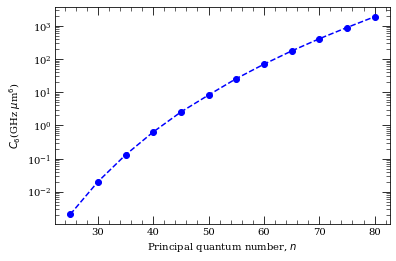
This matches nicely with result from Mukherjee, Rick, “Strong interactions in alkaline-earth Rydberg ensembles”, PhD thesis (2013), (Fig. 3.6)
Pertubative C6 calculation in the manifold of degenerate states#
For states that don’t satisfy \(m_{J1}+m_{J2} = J_1+J_2\), or when there is non-zero angle between the interatomic axis and quantisation axis, in absence of magnetic field all \(m_j\) states are degenerate and some can be coupled with dipole-dipole coupling Hamiltonian. Therefore, we have to use degenerate pertubation theory.
[2]:
atom = Rubidium87()
n = 50
s = 0.5
series = [
[0, 0.5, 0.5],
[1, 0.5, 0.5],
[1, 1.5, 1.5],
[2, 1.5, 1.5],
[2, 2.5, 2.5],
]
f = plt.figure()
ax = f.add_subplot(1, 1, 1)
xtick = []
xticklabel = []
for i, l_j_mj in enumerate(series):
calc = PairStateInteractions(
atom,
n,
l_j_mj[0],
l_j_mj[1],
n,
l_j_mj[0],
l_j_mj[1],
l_j_mj[2],
l_j_mj[2],
s=s,
)
c6, eigenvectors = calc.getC6perturbatively(
0, 0, 4, 30e9, degeneratePerturbation=True
)
# rescale results
c6 = (
c6 / n**11 / 1.4448e-19
) # to get a.u. used in C. Vaillant et.al. paper
x = i * np.ones((len(c6)))
ax.plot(x, c6, "bo")
c6 = calc.getC6perturbatively(0, 0, 4, 30e9, degeneratePerturbation=False)
c6 = (
c6 / n**11 / 1.4448e-19
) # to get a.u. used in C. Vaillant et.al. paper
x = i * np.array([1])
ax.plot(x, c6, "ro")
ax.axvline(x=x[0], linestyle=":", color="grey")
xtick.append(i)
xticklabel.append(
r"$^%d%s_{%d/2}$"
% (2 * s + 1, printStateLetter(l_j_mj[0]), 2 * l_j_mj[1])
)
plt.title(atom.elementName)
ax.get_xaxis().set_ticks(xtick)
ax.set_xticklabels(xticklabel)
plt.ylabel("$C_6n^{-11}$ (a.u.)")
plt.show()
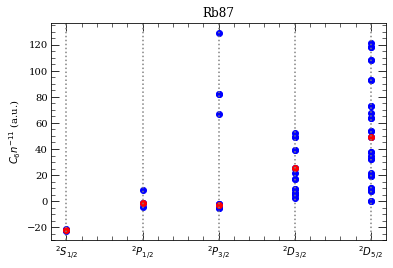
[26]:
atom = Cesium()
n = 50
s = 0.5
series = [
[0, 0.5, 0.5],
[1, 0.5, 0.5],
[1, 1.5, 1.5],
[2, 1.5, 1.5],
[2, 2.5, 2.5],
]
f = plt.figure()
ax = f.add_subplot(1, 1, 1)
xtick = []
xticklabel = []
for i, l_j_mj in enumerate(series):
calc = PairStateInteractions(
atom,
n,
l_j_mj[0],
l_j_mj[1],
n,
l_j_mj[0],
l_j_mj[1],
l_j_mj[2],
l_j_mj[2],
s=s,
)
c6, eigenvectors = calc.getC6perturbatively(
0, 0, 4, 30e9, degeneratePerturbation=True
)
# rescale results
c6 = (
c6 / n**11 / 1.4448e-19
) # to get a.u. used in C. Vaillant et.al. paper
x = i * np.ones((len(c6)))
ax.plot(
x, c6, "bo"
) # - in front of C6 is to match sign definition from C. Vaillant et.al. paper
c6 = calc.getC6perturbatively(0, 0, 4, 30e9, degeneratePerturbation=False)
c6 = (
c6 / n**11 / 1.4448e-19
) # to get a.u. used in C. Vaillant et.al. paper
x = i * np.array([1])
ax.plot(x, c6, "ro")
ax.axvline(x=x[0], linestyle=":", color="grey")
xtick.append(i)
xticklabel.append(
r"$^%d%s_{%d/2}$"
% (2 * s + 1, printStateLetter(l_j_mj[0]), 2 * l_j_mj[1])
)
plt.title(atom.elementName)
ax.get_xaxis().set_ticks(xtick)
ax.set_xticklabels(xticklabel)
plt.ylabel("$C_6n^{-11}$ (a.u.)")
plt.show()
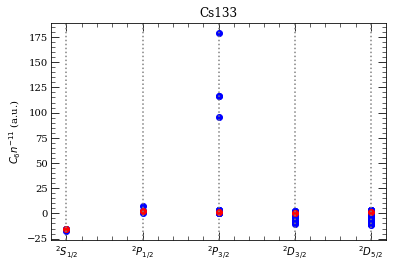
[27]:
atom = Cesium()
n = 50
s = 0.5
series = [
[0, 0.5, 0.5],
[1, 0.5, 0.5],
[1, 1.5, 1.5],
[2, 1.5, 1.5],
[2, 2.5, 2.5],
]
f = plt.figure()
ax = f.add_subplot(1, 1, 1)
xtick = []
xticklabel = []
for i, l_j_mj in enumerate(series):
calc = PairStateInteractions(
atom,
n,
l_j_mj[0],
l_j_mj[1],
n,
l_j_mj[0],
l_j_mj[1],
l_j_mj[2],
l_j_mj[2],
s=s,
)
c6, eigenvectors = calc.getC6perturbatively(
0, 0, 4, 30e9, degeneratePerturbation=True
)
# rescale results
c6 = (
c6 / n**11 / 1.4448e-19
) # to get a.u. used in C. Vaillant et.al. paper
x = i * np.ones((len(c6)))
ax.plot(x, c6, "bo")
c6 = calc.getC6perturbatively(0, 0, 4, 30e9, degeneratePerturbation=False)
c6 = (
c6 / n**11 / 1.4448e-19
) # to get a.u. used in C. Vaillant et.al. paper
x = i * np.array([1])
ax.plot(x, c6, "ro")
ax.axvline(x=x[0], linestyle=":", color="grey")
xtick.append(i)
xticklabel.append(
r"$^%d%s_{%d/2}$"
% (2 * s + 1, printStateLetter(l_j_mj[0]), 2 * l_j_mj[1])
)
plt.title(atom.elementName)
ax.get_xaxis().set_ticks(xtick)
ax.set_xticklabels(xticklabel)
plt.ylabel("$C_6n^{-11}$ (a.u.)")
plt.show()
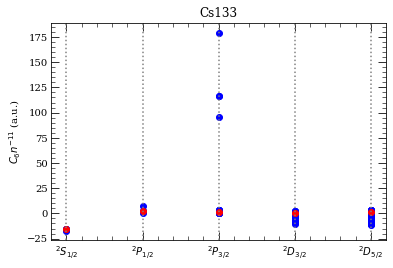
[27]:
atom = Strontium88()
n = 40
s = 0
series = [[0, 0, 0], [1, 1, 1], [2, 2, 2]]
f = plt.figure()
ax = f.add_subplot(1, 1, 1)
xtick = []
xticklabel = []
for i, l_j_mj in enumerate(series):
calc = PairStateInteractions(
atom,
n,
l_j_mj[0],
l_j_mj[1],
n,
l_j_mj[0],
l_j_mj[1],
l_j_mj[2],
l_j_mj[2],
s=s,
)
c6, eigenvectors = calc.getC6perturbatively(
0, 0, 5, 30e9, degeneratePerturbation=True
)
# rescale results
c6 = (
c6 / n**11 / 1.4448e-19
) # to get a.u. used in C. Vaillant et.al. paper
x = i * np.ones((len(c6)))
ax.plot(x, c6, "bo")
ax.axvline(x=x[0], linestyle=":", color="grey")
c6 = calc.getC6perturbatively(0, 0, 4, 30e9, degeneratePerturbation=False)
c6 = (
c6 / n**11 / 1.4448e-19
) # to get a.u. used in C. Vaillant et.al. paper
x = i * np.array([1])
ax.plot(x, c6, "ro")
xtick.append(i)
xticklabel.append(
r"$^%d%s_{%d}$" % (2 * s + 1, printStateLetter(l_j_mj[0]), l_j_mj[1])
)
plt.title(atom.elementName)
ax.get_xaxis().set_ticks(xtick)
ax.set_xticklabels(xticklabel)
plt.ylabel("$C_6n^{-11}$ (a.u.)")
plt.ylim(-120, 40)
plt.show()

[28]:
atom = Strontium88()
n = 40
s = 1
series = [
[0, 1, 1],
[1, 0, 0],
[1, 1, 1],
[1, 2, 2],
[2, 1, 1],
[2, 2, 2],
[2, 3, 3],
]
f = plt.figure()
ax = f.add_subplot(1, 1, 1)
xtick = []
xticklabel = []
for i, l_j_mj in enumerate(series):
calc = PairStateInteractions(
atom,
n,
l_j_mj[0],
l_j_mj[1],
n,
l_j_mj[0],
l_j_mj[1],
l_j_mj[2],
l_j_mj[2],
s=s,
)
c6, eigenvectors = calc.getC6perturbatively(
0, 0, 5, 30e9, degeneratePerturbation=True
)
# rescale results
c6 = (
c6 / n**11 / 1.4448e-19
) # to get a.u. used in C. Vaillant et.al. paper
x = i * np.ones((len(c6)))
ax.plot(x, c6, "bo")
c6 = calc.getC6perturbatively(0, 0, 4, 30e9, degeneratePerturbation=False)
c6 = (
c6 / n**11 / 1.4448e-19
) # to get a.u. used in C. Vaillant et.al. paper
x = i * np.array([1])
ax.plot(x, c6, "ro")
ax.axvline(x=x[0], linestyle=":", color="grey")
xtick.append(i)
xticklabel.append(
r"$^%d%s_{%d}$" % (2 * s + 1, printStateLetter(l_j_mj[0]), l_j_mj[1])
)
plt.title(atom.elementName)
ax.get_xaxis().set_ticks(xtick)
ax.set_xticklabels(xticklabel)
plt.ylabel("$C_6n^{-11}$ (a.u.)")
plt.ylim(-120, 40)
plt.show()
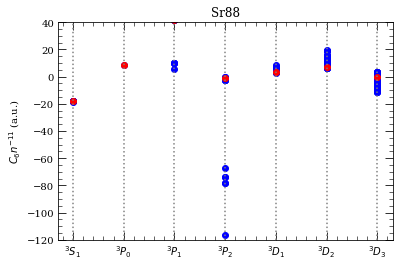
This reproduces (except for \(^3D_2\) series) results from C.V. et al J.Phys B 45, 135004 (2012), Fig. 6.
[30]:
n0 = 30
l0 = 2
j0 = 2
mj0 = 2
# Target State
theta = 0
# Polar Angle [0-pi]
phi = 0
# Azimuthal Angle [0-2pi]
dn = 5
# Range of n to consider (n0-dn:n0+dn)
dl = 5
# Range of l values
deltaMax = 45e9 # Max pair-state energy difference [Hz]
# Set target-state
calc = PairStateInteractions(
Strontium88(), n0, l0, j0, n0, l0, j0, mj0, mj0, interactionsUpTo=1, s=1
)
# R array (um)
rvdw = 0.2
r = np.linspace(rvdw, 1.5, 300)
# Generate pair-state interaction Hamiltonian
calc.defineBasis(
theta, phi, dn, dl, deltaMax, progressOutput=True, debugOutput=False
)
# Diagonalise
nEig = 250 # Number of eigenstates to extract
calc.diagonalise(r, nEig, progressOutput=True)
# Plot
calc.plotLevelDiagram()
# Zoom-on on pair state
calc.ax.set_xlim(0.2, 1.5)
calc.ax.set_ylim(-2, 2)
calc.showPlot() # by default program will plot interactive plots
# however plots are interactive only if open oin standard window
# and not in the %inline mode of the notebooks
Calculating Hamiltonian matrix...
matrix (dimension 1007 )
Matrix R3 100.0 % (state 265 of 265)
Diagonalizing interaction matrix...
99% Now we are plotting...
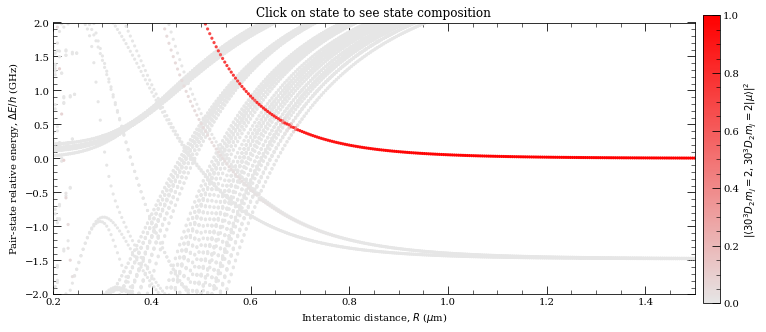
[30]:
0
[31]:
calc.plotLevelDiagram()
# Zoom-on on pair state
calc.ax.set_xlim(0.2, 1.5)
calc.ax.set_ylim(-2, 20)
calc.showPlot() # by default program will plot interactive plots
# however plots are interactive only if open oin standard window
# and not in the %inline mode of the notebooks
Now we are plotting...

[31]:
0
Here we are trying to reproduce Fig. 5.4 (d) from L.J., Christophe Vaillant PhD thesis
[32]:
r = np.linspace(0.2, 0.6, 600)
nEig = 250 # Number of eigenstates to extract
calc.diagonalise(r, nEig, progressOutput=True)
calc.plotLevelDiagram()
# Zoom-on on pair state
calc.ax.set_xlim(0.2, 1.5)
calc.ax.set_ylim(-2, 15)
calc.showPlot() # by default program will plot interactive plots
# however plots are interactive only if open oin standard window
# and not in the %inline mode of the notebooks
Diagonalizing interaction matrix...
99% Now we are plotting...
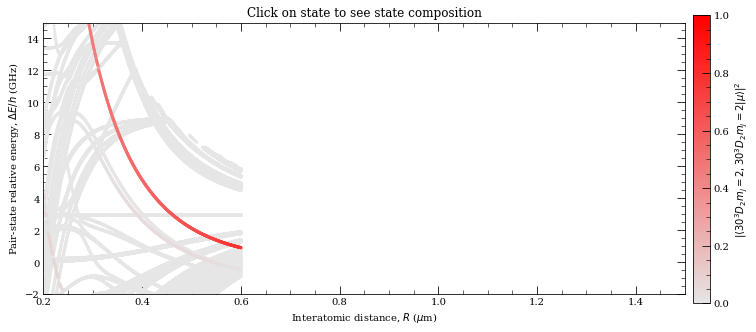
[32]:
0
[33]:
calc.plotLevelDiagram()
# Zoom-on on pair state
calc.ax.set_xlim(0.2, 0.6)
calc.ax.set_ylim(-2, 15)
calc.showPlot() # by default program will plot interactive plots
# however plots are interactive only if open oin standard window
# and not in the %inline mode of the notebooks
Now we are plotting...
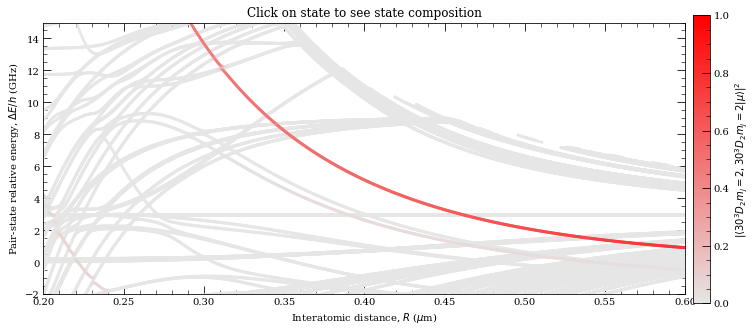
[33]:
0
This basically shows similiar behaviour, however not exactly same. Yet, given that this is close to Le Roy radius, that is in spaghetti region, calculations here are realy sensitive to exact basis states that are included.
Inter-species pair-state calculations#
[29]:
calc = PairStateInteractions(
Rubidium(), 60, 0, 0.5, 54, 0, 0, 0.5, 0, s=0.5, atom2=Ytterbium174(), s2=0
)
[30]:
theta = 0
# Polar Angle [0-pi]
phi = 0
# Azimuthal Angle [0-2pi]
dn = 5
# Range of n to consider (n0-dn:n0+dn)
dl = 5
# Range of l values
deltaMax = 25e9 # Max pair-state energy difference [Hz]
# Generate pair-state interaction Hamiltonian
calc.defineBasis(
theta, phi, dn, dl, deltaMax, progressOutput=True, debugOutput=False
)
# Diagonalise
Calculating Hamiltonian matrix...
matrix (dimension 946 )
Matrix R3 100.0 % (state 263 of 263)
/home/nikola/anaconda3/lib/python3.8/site-packages/numpy/core/_asarray.py:171: VisibleDeprecationWarning: Creating an ndarray from ragged nested sequences (which is a list-or-tuple of lists-or-tuples-or ndarrays with different lengths or shapes) is deprecated. If you meant to do this, you must specify 'dtype=object' when creating the ndarray.
return array(a, dtype, copy=False, order=order, subok=True)
[31]:
r = np.linspace(1, 6, 300)
nEig = 150 # Number of eigenstates to extract
calc.diagonalise(r, nEig, progressOutput=True)
# Plot
calc.plotLevelDiagram()
# Zoom-on on pair state
calc.ax.set_xlim(1, 6)
calc.ax.set_ylim(-2, 2)
calc.showPlot() # by default program will plot interactive plots
# however plots are interactive only if open oin standard window
# and not in the %inline mode of the notebooks
Diagonalizing interaction matrix...
99% Now we are plotting...
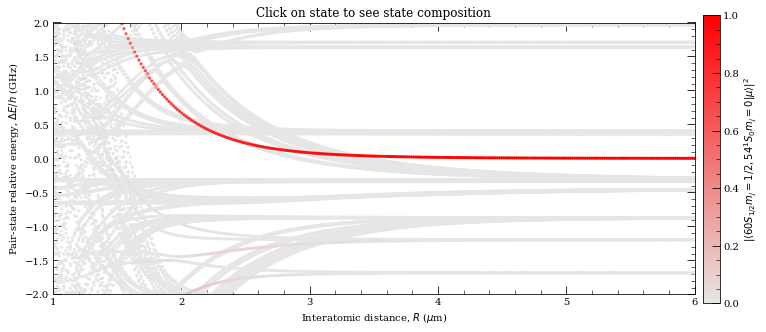
[31]:
0
[32]:
rvdw = calc.getVdwFromLevelDiagram(
1.800000, 6.000000, minStateContribution=0.6, showPlot=True
)
calc.getC3fromLevelDiagram(
1.8, rvdw * 0.99, showPlot=True, minStateContribution=0.5
)
calc.getC6fromLevelDiagram(
1.3 * rvdw, 5.0, showPlot=True, minStateContribution=0.5
)
Data points to fit = 251
Rvdw = 2.3932838618954793 mu m
offset = -9.986838740735977e-07
scale = -8.696094194442242
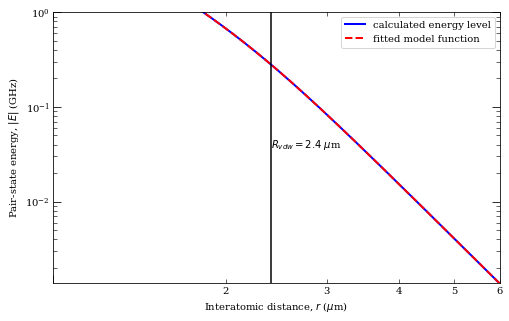
c3 = 7.757664746733516 GHz /R^3 (mu m)^3
offset = -0.29445641367361136
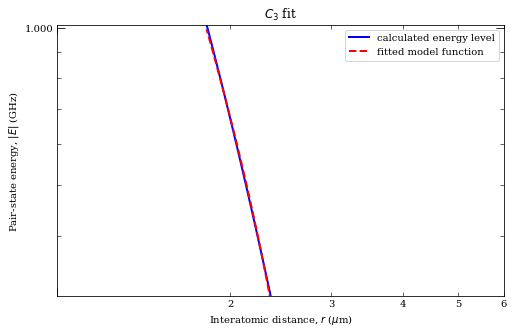
c6 = 62.35616579224586 GHz /R^6 (mu m)^6
offset = 0.00014479688282535122
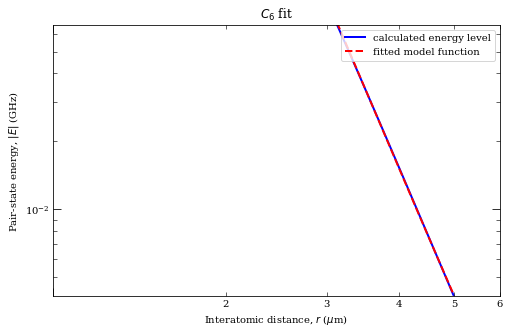
[32]:
62.35616579224586
[33]:
c6 = calc.getC6perturbatively(0, 0, 6, 45e9)
print("C_6 = %.5f GHz (mu m)^6" % (c6))
C_6 = -61.41713 GHz (mu m)^6
[34]:
calc1 = PairStateInteractions(
Rubidium(), 84, 0, 0.5, 89, 0, 0.5, 0.5, 0.5, s=0.5, atom2=Cesium(), s2=0.5
)
calc2 = PairStateInteractions(
Rubidium(), 77, 0, 0.5, 81, 0, 0.5, 0.5, 0.5, s=0.5, atom2=Cesium(), s2=0.5
)
[35]:
# specification of question
thetaList = np.linspace(0, pi / 2.0, 20) # orientations of the two atoms
atomDistance = 12.7 # mu m
# do calculation 1
interactionVeff = []
for t in thetaList:
c6 = calc1.getC6perturbatively(t, 0.0, 5, 25e9)
interactionVeff.append(-(c6 / atomDistance**6) * 1.0e3)
# now plotting
ax = plt.subplot(111)
ax.plot(thetaList / pi * 180, np.array(interactionVeff), "b--")
# symetric plot for 0- >-90
ax.plot(
-thetaList / pi * 180,
np.array(interactionVeff),
"b--",
label="Rb $84 s_{1/2}$, Cs $89 s_{1/2}$",
)
# do calculation 2
interactionVeff = []
for t in thetaList:
c6 = calc2.getC6perturbatively(t, 0.0, 5, 25e9)
interactionVeff.append(-(c6 / atomDistance**6) * 1.0e3)
# now plotting
ax.plot(thetaList / pi * 180, np.array(interactionVeff), "r-")
# symetric plot for 0- >-90
ax.plot(
-thetaList / pi * 180,
np.array(interactionVeff),
"r-",
label="Rb $77 s_{1/2}$, Cs $81 s_{1/2}$",
)
ax.legend()
ax.set_xlabel(r"Angle, $\theta (^\circ)$")
ax.set_ylabel(r"Interactions, $|V_{\rm eff}|/h$ (MHz)")
ax.set_xlim(-90, 90)
ax.set_title(r"Rb-Cs interspecies interactions at $R=12.4 \mu$m")
plt.show()
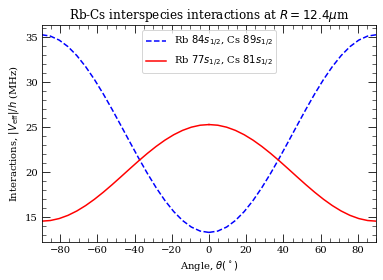
This matches with Fig. 7 in Phys. Rev. A 92, 042710 (2015) https://doi.org/10.1103/PhysRevA.92.042710
Stark-tuned Forster resonances#
[39]:
calculation = StarkMapResonances(
Strontium88(preferQuantumDefects=True),
[40, 0, 0, 0, 0],
Strontium88(preferQuantumDefects=True),
[40, 2, 2, 0, 0],
)
calculation.findResonances(
35,
45,
20,
np.linspace(0, 400, 200),
energyRange=[-1e8, 2.0e8],
progressOutput=True,
)
calculation.showPlot()
Found 210 states.
Generating matrix...
100%
Finding eigenvectors...
100%
Found 210 states.
Generating matrix...
100%
Finding eigenvectors...
100%
Found 200 states.
Generating matrix...
100%
Finding eigenvectors...
100%
Found 200 states.
Generating matrix...
100%
Finding eigenvectors...
100%
E=400.00 V/m
Found 210 states.
Generating matrix...
100%
Finding eigenvectors...
100%
E=400.00 V/m
Found 200 states.
Generating matrix...
100%
Finding eigenvectors...
100%
E=400.00 V/m
Found 210 states.
Generating matrix...
100%
Finding eigenvectors...
100%
Found 200 states.
Generating matrix...
100%
Finding eigenvectors...
100%
E=400.00 V/m
Found 210 states.
Generating matrix...
100%
Finding eigenvectors...
100%
E=400.00 V/m
Found 200 states.
Generating matrix...
100%
Finding eigenvectors...
100%
E=400.00 V/m
Found 200 states.
Generating matrix...
100%
Finding eigenvectors...
100%
Found 200 states.
Generating matrix...
100%
Finding eigenvectors...
100%
E=400.00 V/m
Found 210 states.
Generating matrix...
100%
Finding eigenvectors...
100%
E=400.00 V/m
Found 200 states.
Generating matrix...
100%
Finding eigenvectors...
100%
E=400.00 V/m
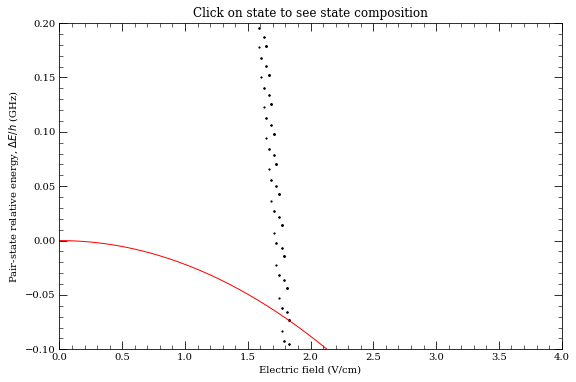
[40]:
calculation.atom2.energyLevelsExtrapolated
[40]:
True
Wavefunction calculations for Alkali atom Rydberg states#
[38]:
atom = Rubidium()
n = 10
l = 1
j = 1.5
mj = 1.5
wf = Wavefunction(atom, [[n, l, j, mj]], [1])
wf.plot2D(plane="x-z", units="atomic")
plt.show()
wf.plot3D(plane="x-z", units="atomic")
plt.show()
wf.plot2D(plane="x-y", units="atomic")
plt.show()

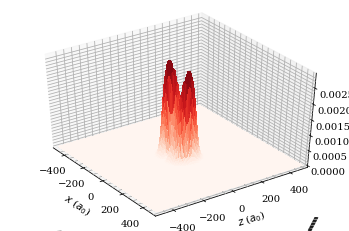
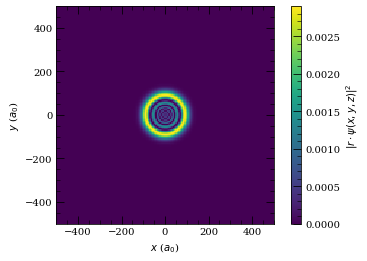
[39]:
calc = StarkMap(Cesium())
states, coef, energy = calc.getState(
[28, 0, 0.5, 0.5],
-24000,
23,
32,
20,
accountForAmplitude=0.95,
debugOutput=True,
)
atom = Cesium()
wf = Wavefunction(atom, states, coef)
wf.plot2D(plane="x-z", units="nm", pointsPerAxis=400, axisLength=2800)
plt.show()
wf.plot3D(plane="x-z", units="nm", pointsPerAxis=400, axisLength=2800)
plt.show()
wf.plot2D(plane="x-y", units="nm", pointsPerAxis=400, axisLength=2800)
plt.show()
Max overlap = 0.168
Eigen energy (state index 73) = -192.58 eV
Maximum contributions to this state
-0.4102815212568417
[28, 0, 0.5, 0.5]
-0.27654613145110857
[28, 1, 1.5, 0.5]
0.21332031019519113
[27, 1, 1.5, 0.5]
0.21166675717643682
[28, 1, 0.5, 0.5]
===========
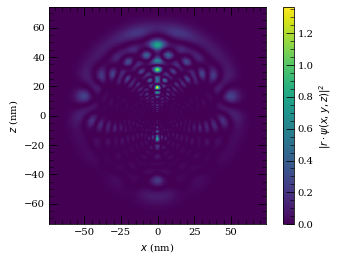
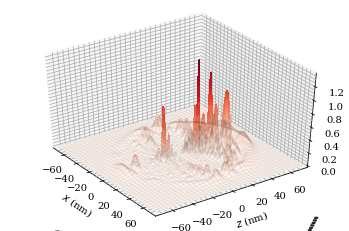
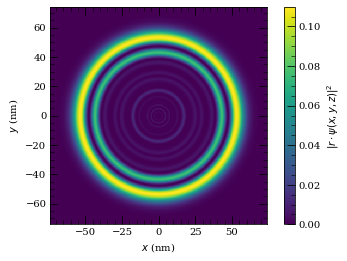
Atom-surface van der Waals interactions (C3 calculation)#
[40]:
from arc.materials import Sapphire
atom = Cesium()
surface = Sapphire()
calc = AtomSurfaceVdW(atom, surface)
n1 = 6
l1 = 0
j1 = 0.5
coupledStates = [[6, 1, 0.5], [6, 1, 1.5], [7, 1, 0.5], [7, 1, 1.5]]
c3_1, c3_1_err = calc.getStateC3(n1, l1, j1, coupledStates, debugOutput=True)
6 2S 1/2 -> C3 contr. (kHz mum^3) lambda (mum) n
-> 6 2P 1/2 0.418 +- 0.001 0.895 1.758
-> 6 2P 3/2 0.831 +- 0.001 0.852 1.759
-> 7 2P 1/2 0.002 +- 0.000 0.459 1.778
-> 7 2P 3/2 0.007 +- 0.000 0.456 1.779
= = = = = = Total shift of 6 2S 1/2 = 1.258+-0.0017 kHz mum^3
[41]:
n2 = 6
l2 = 1
j2 = 0.5
coupledStates = [
[6, 0, 0.5],
[7, 0, 0.5],
[8, 0, 0.5],
[9, 0, 0.5],
[10, 0, 0.5],
[5, 2, 1.5],
[6, 2, 1.5],
[7, 2, 1.5],
[8, 2, 1.5],
[9, 2, 1.5],
[10, 2, 1.5],
[11, 2, 1.5],
]
c3_2, c3_2_err = calc.getStateC3(n2, l2, j2, coupledStates, debugOutput=True)
6 2P 1/2 -> C3 contr. (kHz mum^3) lambda (mum) n
-> 6 2S 1/2 0.418 +- 0.001 -0.895 1.758
-> 7 2S 1/2 0.371 +- 0.001 1.359 1.749
-> 8 2S 1/2 0.023 +- 0.002 0.761 1.761
-> 9 2S 1/2 0.006 +- 0.000 0.636 1.766
-> 10 2S 1/2 0.003 +- 0.000 0.584 1.768
-> 5 2D 3/2 1.006 +- 0.021 3.011 1.712
-> 6 2D 3/2 0.372 +- 0.009 0.876 1.758
-> 7 2D 3/2 0.088 +- 0.001 0.673 1.764
-> 8 2D 3/2 0.036 +- 0.003 0.601 1.767
-> 9 2D 3/2 0.019 +- 0.001 0.567 1.769
-> 10 2D 3/2 0.011 +- 0.001 0.547 1.771
-> 11 2D 3/2 0.007 +- 0.001 0.534 1.772
= = = = = = Total shift of 6 2P 1/2 = 2.359+-0.0235 kHz mum^3
[42]:
c3 = (c3_2 - c3_1) / C_h * (1e6) ** 3 * 1e-3
c3_err = np.sqrt(c3_2_err**2 + c3_1_err**2) / C_h * (1e6) ** 3 * 1e-3
print(
"C_3 for transitions %s -> %s in contact with %s surface is %.3f +- %.3f kHz mum^3"
% (
printStateString(n1, l1, j1),
printStateString(n2, l2, j2),
surface.name,
c3,
c3_err,
)
)
C_3 for transitions 6 S 1/2 -> 6 P 1/2 in contact with Sapphire surface is 1.102 +- 0.024 kHz mum^3
Optical lattice calculations (Bloch bands, Wannier states…)#
Example of Bloch band structure with very weak optical lattice (depth of 4 recoil energies).
[43]:
atom = Rubidium87()
trapWavelength = 1064e-9
lattice = OpticalLattice1D(atom, trapWavelength)
trapPotentialDepth = np.array([4, 4, 4]) * lattice.getRecoilEnergy()
trapFreq = lattice.getTrappingFrequency(trapPotentialDepth)
print(
"Omega_x = %.2f kHz\nOmega_y = %.2f kHz\nOmega_z = %.2f kHz"
% (trapFreq[0] * 1e-3, trapFreq[1] * 1e-3, trapFreq[2] * 1e-3)
)
lattice.defineBasis(35)
qMomentum = np.linspace(-1, 1, 100)
lattice.diagonalise(4, qMomentum, saveBandIndex=0)
fig = lattice.plotLevelDiagram()
plt.show()
Omega_x = 50.96 kHz
Omega_y = 50.96 kHz
Omega_z = 50.96 kHz

We can see Bloch wavefunctions first.
[44]:
f = lattice.BlochWavefunction(4, +0.0, 0)
xList = np.linspace(-2 * np.pi, 2 * np.pi, 300)
y = []
for x in xList:
y.append(f(x))
y = np.array(y)
f = plt.figure(figsize=(15, 6))
ax1 = f.add_subplot(1, 2, 1)
ax2 = f.add_subplot(1, 2, 2)
ax1.plot(xList, np.real(y), "-", color="g")
# ax1.plot(xList, np.imag(y), "r--")
ax1.set_xlabel(r"Real space distance, $x k $")
plt.title("Real and imaginary part")
# plt.show()
ax2.plot(xList, np.absolute(y) ** 2, "-", color="r")
ax2.set_xlabel(r"Real space distance, $x k $")
plt.title(r"Density $|\psi_q^{(n)}|^2$")
plt.show()

If we plot band structure, we see energy clear gaps opening.
[45]:
atom = Rubidium87()
trapWavelength = 1064e-9
lattice = OpticalLattice1D(atom, trapWavelength)
trapPotentialDepth = np.array([40, 40, 80]) * lattice.getRecoilEnergy()
trapFreq = lattice.getTrappingFrequency(trapPotentialDepth)
print(
"Omega_x = %.2f kHz\nOmega_y = %.2f kHz\nOmega_z = %.2f kHz"
% (trapFreq[0] * 1e-3, trapFreq[1] * 1e-3, trapFreq[2] * 1e-3)
)
Vlat = 40
lattice.defineBasis(25)
qMomentum = np.linspace(-1, 1, 100)
lattice.diagonalise(Vlat, qMomentum, saveBandIndex=0)
fig = lattice.plotLevelDiagram()
plt.show()
k = 1
xList = np.linspace(-2 * pi, 2 * pi, 201)
y = []
opticalLattice = []
for x in xList:
y.append(lattice.getWannierFunction(x, latticeIndex=0))
opticalLattice.append(40 - 40 * np.cos(k * x) ** 2)
Omega_x = 161.16 kHz
Omega_y = 161.16 kHz
Omega_z = 227.92 kHz

Now let’s plot them and compare them with Linear harmonic oscilator ground state
[46]:
sigma = 67.34e-9
sigmaGauss_nm = sigma * 1.0e9
ac = lattice.trapWavenegth / 2
def lhoGroundState(x, sigma):
return (
1.0
/ ((np.pi * sigma**2) ** (1.0 / 4.0))
* np.exp(-(x**2) / (2.0 * sigma**2))
)
def align_yaxis(ax1, v1, ax2, v2):
"""adjust ax2 ylimit so that v2 in ax2 is aligned to v1 in ax1"""
_, y1 = ax1.transData.transform((0, v1))
_, y2 = ax2.transData.transform((0, v2))
inv = ax2.transData.inverted()
_, dy = inv.transform((0, 0)) - inv.transform((0, y1 - y2))
miny, maxy = ax2.get_ylim()
ax2.set_ylim(miny + dy, maxy + dy)
dx = abs(xList[1] - xList[0])
print(dx)
y = np.array(y)
norm = np.linalg.norm(y) * sqrt(dx)
y = y / norm
s = 0
for i in range(len(y)):
s += (y[i].real ** 2 + y[i].imag ** 2) * dx
print("Norm = ", s)
popt, pcov = curve_fit(
lhoGroundState,
xList,
np.absolute(y),
p0=[sigmaGauss_nm * 1e-9 / (ac / (np.pi))],
)
sigmaFit = popt[0] * (ac / (np.pi)) * 1e9
print("Fitted gaussian 1/e width of probability = %.2f nm" % sigmaFit)
f = plt.figure(figsize=(14, 5))
ax1 = f.add_subplot(1, 2, 1)
ax1.plot(xList, np.real(y), "r-", lw=2)
lhog = []
print("Calculated Gaussian width for LHO = %.2f nm" % sigmaGauss_nm)
for x in xList:
lhog.append(lhoGroundState(x, sigmaGauss_nm * 1e-9 / (ac / (np.pi))))
# lhog.append(lhoGroundState(x, sigmaFit*1e-9 / (ac/(np.pi))) )
ax1.plot(xList, lhog, "k--", lw=2)
plt.legend((r"Wannier function, $w(x)$", r"LHO ground state, $\psi_{LHO}(x)$"))
# plt.plot(xList, np.absolute(y)**2, "r-")
ax2 = ax1.twinx()
ax2.plot(xList, opticalLattice, "b-", alpha=0.4, lw=3)
ax2.axhline(linewidth=1, color="0.8", zorder=-5)
ax1.set_xlabel(r"Distance, $x k$")
ax2.set_ylim(-1, 1.1 * Vlat)
ax2.set_xlim(-2 * np.pi, 2 * np.pi)
# ax2.set_xlim(-3, 3)
ax2.set_ylabel("Optical potential, $V(x)$ ($E_r$)", color="b")
ax1.set_ylabel(r"Wavefunction", color="r")
align_yaxis(ax1, 0, ax2, 0)
plt.title(
r"$V_{\rm lat} = %.1f E_{\rm r}$, $k = 2\pi/\lambda = \pi/a_c$, $ \sigma_{\rm W} = %.0f$ nm, $\sigma_{\rm LHO} = %.0f$ nm"
% (Vlat, sigmaFit, (sigma * 1.0e9))
)
ax3 = f.add_subplot(1, 2, 2)
probDensityDis = np.absolute(y) ** 2
ax3.plot(xList, probDensityDis, "r-", lw=2)
ax3.set_ylabel(r"Probability density", color="r")
ax3.axhline(linewidth=1, color="0.8")
ax3.fill_between(xList, 0, probDensityDis, color="r", alpha=0.3)
ax3.plot(xList, np.array(lhog) ** 2, "k--", lw=2)
ax4 = ax3.twinx()
ax4.plot(xList, opticalLattice, "b-", alpha=0.4, lw=3)
ax3.set_xlabel(r"Distance, $x k$")
# ax3.axvspan(xList[stop], xList[start], alpha=0.5, color='red')
ax4.set_ylim(-1, 1.1 * Vlat)
ax4.set_xlim(-2 * np.pi, 2 * np.pi)
ax4.set_ylabel("Optical potential, $V(x)$ ($E_r$)", color="b")
align_yaxis(ax3, 0, ax4, 0)
conversion = 1.0 / np.pi * ac * 1e9
axS = ax3.twiny()
mn, mx = ax3.get_xlim()
axS.set_xlim(mn * conversion, mx * conversion)
axS.set_xlabel("Distance along the lattice (nm)")
plt.tight_layout()
plt.show()
0.06283185307179551
Norm = 1.0000000000000009
Fitted gaussian 1/e width of probability = 70.41 nm
Calculated Gaussian width for LHO = 67.34 nm

Calculations of dynamic polarisability and magic wavelengths for optical traps#
[3]:
atom = Cesium()
n = 10
calc = DynamicPolarizability(atom, n, 1, 1.5)
calc.defineBasis(atom.groundStateN, n + 15)
alpha0, alpha1, alpha2, core, dynamic, closestState = calc.getPolarizability(
1100e-9, units="au", accountForStateLifetime=True
)
print("alpha0 = %.3e a.u." % (alpha0))
print("alpha2 = %.3e a.u." % (alpha2))
alpha0 = -4.699e+02 a.u.
alpha2 = -2.370e+01 a.u.
[21]:
atom = Cesium()
n = 7
calc = DynamicPolarizability(atom, n, 1, 0.5)
calc.defineBasis(atom.groundStateN, n + 15)
calc.getPolarizability(1100e-9, units="a.u.")
calcGroundState = DynamicPolarizability(atom, 6, 0, 0.5)
calcGroundState.defineBasis(atom.groundStateN, 25)
wavelengthList = np.linspace(1160, 1300, 1000) * 1e-9 # m
ax = calc.plotPolarizability(wavelengthList, debugOutput=True, units="au")
calcGroundState.plotPolarizability(
wavelengthList, debugOutput=True, units="au", addToPlotAxis=ax, line="r--"
)
import matplotlib.lines as mlines
ax.set_ylim(-2500, 2000)
plt.legend(
handles=[
mlines.Line2D(
[],
[],
color="b",
linestyle="-",
label=(r"$\alpha[%s]$" % printStateStringLatex(n, 1, 0.5)),
),
mlines.Line2D(
[],
[],
color="r",
linestyle="--",
label=(r"$\alpha[%s]$" % printStateStringLatex(6, 0, 0.5)),
),
],
loc="lower right",
)
plt.show()
Resonance: 1172.05 nm 14 2S 1/2
Resonance: 1186.07 nm 12 2D 3/2
Resonance: 1209.19 nm 13 2S 1/2
Resonance: 1229.93 nm 11 2D 3/2
Resonance: 1265.39 nm 12 2S 1/2
Resonance: 1298.32 nm 10 2D 3/2

[22]:
wavelengthList = np.linspace(1300, 1800, 1000) * 1e-9 # m
ax = calc.plotPolarizability(wavelengthList, debugOutput=True, units="au")
calcGroundState.plotPolarizability(
wavelengthList, debugOutput=True, units="au", addToPlotAxis=ax, line="r--"
)
import matplotlib.lines as mlines
ax.set_ylim(-6500, 6500)
plt.legend(
handles=[
mlines.Line2D(
[],
[],
color="b",
linestyle="-",
label=(r"$\alpha[%s]$" % printStateStringLatex(n, 1, 0.5)),
),
mlines.Line2D(
[],
[],
color="r",
linestyle="--",
label=(r"$\alpha[%s]$" % printStateStringLatex(6, 0, 0.5)),
),
],
loc="lower right",
)
plt.show()
Resonance: 1357.56 nm 11 2S 1/2
Resonance: 1376.58 nm 5 2D 3/2
Resonance: 1416.12 nm 9 2D 3/2
Resonance: 1530.73 nm 10 2S 1/2
Resonance: 1654.35 nm 8 2D 3/2
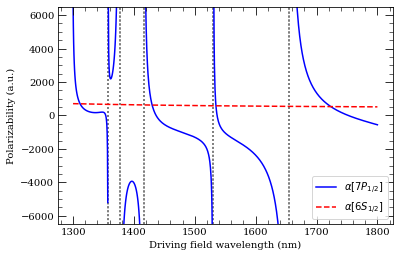
[6]:
atom = Cesium()
n = 7
calc = DynamicPolarizability(atom, n, 1, 1.5)
calc.defineBasis(atom.groundStateN, 16)
calcGroundState = DynamicPolarizability(atom, 6, 0, 0.5)
calcGroundState.defineBasis(atom.groundStateN, 16)
wavelengthList = np.linspace(1160, 1300, 2000) * 1e-9 # m
ax = calc.plotPolarizability(
wavelengthList, mj=0.5, debugOutput=True, units="au", line="b-"
)
ax = calc.plotPolarizability(
wavelengthList,
mj=1.5,
debugOutput=True,
units="au",
addToPlotAxis=ax,
line="g-",
)
calcGroundState.plotPolarizability(
wavelengthList, debugOutput=True, units="au", addToPlotAxis=ax, line="r--"
)
import matplotlib.lines as mlines
ax.set_ylim(-2500, 3000)
ax.set_xlim(1160, 1300)
plt.legend(
handles=[
mlines.Line2D(
[],
[],
color="b",
linestyle="-",
label=(
r"$\alpha[%s |m_j|=1/2]$" % printStateStringLatex(n, 1, 0.5)
),
),
mlines.Line2D(
[],
[],
color="g",
linestyle="-",
label=(
r"$\alpha[%s |m_j|=3/2]$" % printStateStringLatex(n, 1, 1.5)
),
),
mlines.Line2D(
[],
[],
color="r",
linestyle="--",
label=(r"$\alpha[%s]$" % printStateStringLatex(6, 0, 0.5)),
),
],
loc="lower right",
)
plt.show()
Resonance: 1170.37 nm 15 2S 1/2
Resonance: 1180.52 nm 13 2D 5/2
Resonance: 1197.47 nm 14 2S 1/2
Resonance: 1211.76 nm 12 2D 5/2
Resonance: 1236.20 nm 13 2S 1/2
Resonance: 1257.42 nm 11 2D 5/2
Resonance: 1294.96 nm 12 2S 1/2
Resonance: 1180.52 nm 13 2D 5/2
Resonance: 1211.76 nm 12 2D 5/2
Resonance: 1212.11 nm 12 2D 3/2
Resonance: 1257.42 nm 11 2D 5/2
Resonance: 1257.91 nm 11 2D 3/2
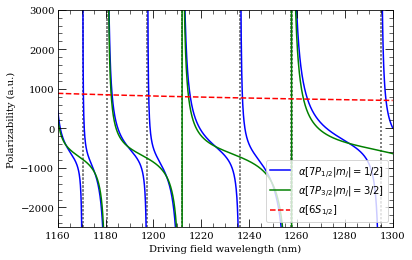
[7]:
wavelengthList = np.linspace(1300, 1850, 2000) * 1e-9 # m
ax = calc.plotPolarizability(
wavelengthList, mj=0.5, debugOutput=True, units="au", line="b-"
)
ax = calc.plotPolarizability(
wavelengthList,
mj=1.5,
debugOutput=True,
units="au",
addToPlotAxis=ax,
line="g-",
)
calcGroundState.plotPolarizability(
wavelengthList, debugOutput=True, units="au", addToPlotAxis=ax, line="r--"
)
import matplotlib.lines as mlines
ax.set_ylim(-3000, 3000)
ax.set_xlim(1300, 1850)
plt.legend(
handles=[
mlines.Line2D(
[],
[],
color="b",
linestyle="-",
label=(
r"$\alpha[%s |m_j|=1/2]$" % printStateStringLatex(n, 1, 0.5)
),
),
mlines.Line2D(
[],
[],
color="g",
linestyle="-",
label=(
r"$\alpha[%s |m_j|=3/2]$" % printStateStringLatex(n, 1, 0.5)
),
),
mlines.Line2D(
[],
[],
color="r",
linestyle="--",
label=(r"$\alpha[%s]$" % printStateStringLatex(6, 0, 0.5)),
),
],
loc="lower right",
)
plt.show()
Resonance: 1328.89 nm 10 2D 5/2
Resonance: 1342.92 nm 5 2D 3/2
Resonance: 1360.81 nm 5 2D 5/2
Resonance: 1391.90 nm 11 2S 1/2
Resonance: 1451.60 nm 9 2D 5/2
Resonance: 1574.04 nm 10 2S 1/2
Resonance: 1701.70 nm 8 2D 5/2
Resonance: 1328.89 nm 10 2D 5/2
Resonance: 1329.71 nm 10 2D 3/2
Resonance: 1342.92 nm 5 2D 3/2
Resonance: 1360.81 nm 5 2D 5/2
Resonance: 1451.60 nm 9 2D 5/2
Resonance: 1453.25 nm 9 2D 3/2
Resonance: 1701.70 nm 8 2D 5/2
Resonance: 1705.28 nm 8 2D 3/2
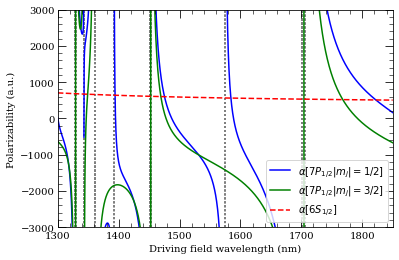
[4]:
wavelengthList = np.linspace(1450, 1600, 1000) * 1e-9 # m
ax = calc.plotPolarizability(
wavelengthList, mj=0.5, debugOutput=True, units="au", line="b-"
)
ax = calc.plotPolarizability(
wavelengthList,
mj=1.5,
debugOutput=True,
units="au",
addToPlotAxis=ax,
line="g-",
)
calcGroundState.plotPolarizability(
wavelengthList, debugOutput=True, units="au", addToPlotAxis=ax, line="r--"
)
import matplotlib.lines as mlines
ax.set_ylim(-3000, 3000)
ax.set_xlim(1452, 1600)
plt.legend(
handles=[
mlines.Line2D(
[],
[],
color="b",
linestyle="-",
label=(
r"$\alpha[%s |m_j|=1/2]$" % printStateStringLatex(n, 1, 0.5)
),
),
mlines.Line2D(
[],
[],
color="g",
linestyle="-",
label=(
r"$\alpha[%s |m_j|=3/2]$" % printStateStringLatex(n, 1, 0.5)
),
),
mlines.Line2D(
[],
[],
color="r",
linestyle="--",
label=(r"$\alpha[%s]$" % printStateStringLatex(6, 0, 0.5)),
),
],
loc="lower right",
)
plt.show()
Resonance: 1451.65 nm 9 2D 5/2
Resonance: 1453.15 nm 9 2D 3/2
Resonance: 1573.87 nm 10 2S 1/2
Resonance: 1451.65 nm 9 2D 5/2
Resonance: 1453.15 nm 9 2D 3/2
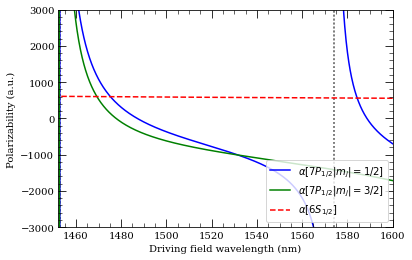
[3]:
atom = Cesium()
n = 7
calc = DynamicPolarizability(atom, n, 1, 0.5)
calc.defineBasis(atom.groundStateN, n + 15)
calc.getPolarizability(1100e-9, units="a.u.")
calcGroundState = DynamicPolarizability(atom, 6, 0, 0.5)
calcGroundState.defineBasis(atom.groundStateN, 25)
wavelengthList = np.linspace(1160, 1300, 1000) * 1e-9 # m
ax = calc.plotPolarizability(wavelengthList, debugOutput=True, units="au")
calcGroundState.plotPolarizability(
wavelengthList, debugOutput=True, units="au", addToPlotAxis=ax, line="r--"
)
import matplotlib.lines as mlines
ax.set_ylim(-2500, 2000)
plt.legend(
handles=[
mlines.Line2D(
[],
[],
color="b",
linestyle="-",
label=(r"$\alpha[%s]$" % printStateStringLatex(n, 1, 0.5)),
),
mlines.Line2D(
[],
[],
color="r",
linestyle="--",
label=(r"$\alpha[%s]$" % printStateStringLatex(6, 0, 0.5)),
),
],
loc="lower right",
)
plt.show()
Resonance: 1172.05 nm 14 2S 1/2
Resonance: 1186.07 nm 12 2D 3/2
Resonance: 1209.19 nm 13 2S 1/2
Resonance: 1229.93 nm 11 2D 3/2
Resonance: 1265.39 nm 12 2S 1/2
Resonance: 1298.32 nm 10 2D 3/2

[ ]: